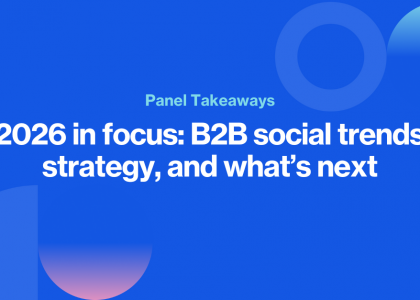The quest to understand how people make buying decisions has probably consumed more brainpower than any other topic in marketing and sales. In B2B, we’ve also devoted a lot of time and energy to diagnosing why some potential customers fail to make any purchase after conducting a thorough buying process.
Such outcomes are usually called no decisions, and several studies have shown that B2B companies lose more sales to no decisions than to competitors. In the research for their 2022 book, The JOLT Effect, Matthew Dixon and Ted McKenna found that between 40% and 60% of prospective sales result in no decisions.
Rational vs. Non-Rational No Decisions
Some no decisions are entirely rational. For example, a potential customer may decide not to buy because their current solution is superior or equivalent to the proposed alternatives. In such cases, the alternatives don’t provide enough additional value to justify a change.
However, many no decisions can’t be explained on a rational basis. These are situations where the potential customer has recognized the existence of an issue or challenge that needs to be addressed, the fit and business case for the proposed solution are strong, and the price of the proposed solution is affordable. But despite these circumstances, the potential customer decides not to buy.
Such “non-rational” no decisions point to the role of human emotion and psychology in B2B buying. An impressive body of research has shown that many B2B buying decisions are driven more by emotional and psychological factors than by logic.
So, how do emotions and psychological factors drive no decisions? To answer this question, the starting point is understanding the power and prevalence of fear in B2B buying.
How Fear Drives No Decisions
More than a decade ago, Enquiro conducted a landmark study of the B2B buying process. The research used several methods to gather data from almost 4,000 individuals involved in B2B buying. A core finding of the study was that B2B buying is not a rational process, but rather an “emotional, heuristic process” in which fear plays a leading role.
Gord Hotchkiss, the CEO of Enquiro, discussed the results of the study in The Buyersphere Project, where he described the role of fear in B2B buying in unequivocal terms. He wrote:
“B2B buying decisions are usually driven by one emotion – fear. Specifically, B2B buying is all about minimizing fear by eliminating risk. And in that, there are two distinct types of risk. There is organizational risk, typically formalized and dealt with in various procurement processes and then there is personal risk, which is unstated but remains a huge influencing factor in organizational buying.”
The personal risk that is present at some level in every B2B buying situation is the risk that the decision-maker will be blamed if the purchase doesn’t deliver the promised benefits. So, fear of blame is a hidden force in every B2B buying situation.
Personal risk often causes business buyers to practice what psychologist Gerd Gigerenzer has called defensive decision-making.*
Defensive decision-making occurs when a business buyer doesn’t choose the option that would probably produce the most benefits for his or her company, but instead chooses the option that will protect him or her in case something goes wrong.
Defensive decision-making can easily lead business buyers to view their status quo as the safest option, and that results in a no decision.
A Strong Brand Reduces No Decisions
You will never completely eliminate no decisions. As I noted earlier, some no decisions are completely rational. Sometimes, your offering won’t be significantly better than what your prospect is already using or doing. Your objective should be to identify these situations early in the sales process so that you don’t waste time pursuing a deal you are unlikely to win.
Reducing the number of non-rational no decisions is challenging because, by definition, you are dealing with emotional and psychological factors that are difficult to identify and usually differ for every buyer.
In The JOLT Effect, Dixon and McKenna lay out a four-pronged approach that sales reps can use to reduce no decisions. The authors argue that high-performing reps look for ways to “take risk off the table” (the “T” in JOLT). Examples of these tactics include free trials, opt-out clauses in contracts, and performance guarantees.
One of the most effective ways to reduce non-rational no decisions is to build and sustain a strong brand presence in the relevant market. A strong brand reduces the level of personal risk associated with choosing your company.
If your company/brand is well-known by the decision-maker’s superiors and colleagues, the perceived risk is even lower. This explains the rationale of the quote: “Nobody ever got fired for buying IBM.”
In a recent paper published by The B2B Institute, Rory Sutherland, Vice Chairman of Ogilvy UK and author of Alchemy, described the power of a strong brand to reduce risks:
“A decision to appoint a respected brand is much less reputationally risky than the appointment of an unknown. If you appoint a well-known company to a task and things go wrong, your colleagues are likely to blame the supplier. If you appoint someone obscure, they may blame you.”
Advocates of brand marketing often assert that building a strong brand will improve the performance of demand generation programs, make buyers more willing to pay a premium price, and increase customer loyalty. Unfortunately, it’s not usually clear why a strong brand delivers these benefits. One likely reason is that buyers are apt to view a strong brand as the safest choice.
*Gerd Gigerenzer is director emeritus at the Max Planck Institute for Human Development in Berlin, and director of the Harding Center for Risk Literacy at the University of Potsdam. For a more in-depth discussion of defensive decision-making, see his book, Risk Savvy: How to Make Good Decisions.




